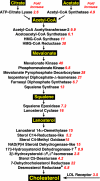Combined analysis of oligonucleotide microarray data from transgenic and knockout mice identifies direct SREBP target genes
- PMID: 14512514
- PMCID: PMC218707
- DOI: 10.1073/pnas.1534923100
Combined analysis of oligonucleotide microarray data from transgenic and knockout mice identifies direct SREBP target genes
Abstract
The synthesis of fatty acids and cholesterol, the building blocks of membranes, is regulated by three membrane-bound transcription factors: sterol regulatory element-binding proteins (SREBP)-1a, -1c, and -2. Their function in liver has been characterized in transgenic mice that overexpress each SREBP isoform and in mice that lack all three nuclear SREBPs as a result of gene knockout of SREBP cleavage-activating protein (SCAP), a protein required for nuclear localization of SREBPs. Here, we use oligonucleotide arrays hybridized with RNA from livers of three lines of mice (transgenic for SREBP-1a, transgenic for SREBP-2, and knockout for SCAP) to identify genes that are likely to be direct targets of SREBPs in liver. A total of 1,003 genes showed statistically significant increased expression in livers of transgenic SREBP-1a mice, 505 increased in livers of transgenic SREBP-2 mice, and 343 showed decreased expression in Scap-/- livers. A subset of 33 genes met the stringent combinatorial criteria of induction in both SREBP transgenics and decreased expression in SCAP-deficient mice. Of these 33 genes, 13 were previously identified as direct targets of SREBP action. Of the remaining 20 genes, 13 encode enzymes or carrier proteins involved in cholesterol metabolism, 3 participate in fatty acid metabolism, and 4 have no known connection to lipid metabolism. Through application of stringent combinatorial criteria, the transgenic/knockout approach allows identification of genes whose activities are likely to be controlled directly by one family of transcription factors, in this case the SREBPs.
Figures


References
Publication types
MeSH terms
Substances
Grants and funding
LinkOut - more resources
Full Text Sources
Other Literature Sources
Molecular Biology Databases
Miscellaneous

